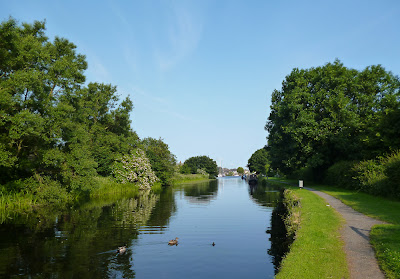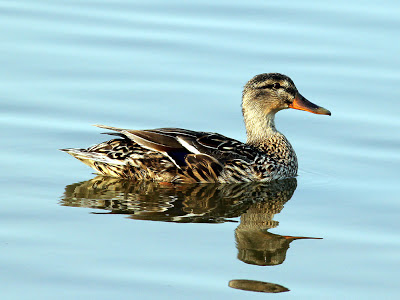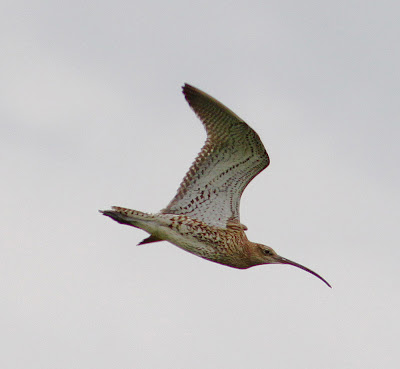It was the Cockerham round today - Conder Green, Glasson and Cockersands.
Common Sandpipers continue to pass through with 11 today, joined in the creek by 25+ Redshanks, 1 Curlew and a summer plumaged Spotted Redshank.
At this time of year adults spot-reds look totally different from their autumn and winter cold-grey plumage. Although July seems early for returning migrants from relatively cold northern climes, female Spotted Redshanks leave breeding sites first. Exhausted from producing eggs, it is an advantage for them to arrive at staging areas early and have first pick of the food. Males usually leave next, and juveniles later. These waves are not due to the lack of food on the northern summer grounds, but because there is more food at the staging area for those that arrive first. Female Spotted Redshanks sometimes leave up to a week before eggs hatch, leaving males to look after the youngsters, a breeding and survival strategy adopted by other wader species.
It is a number of years since a mid June outing to the then undisturbed River Ribble found 14 of the black beauties on a tidal pool that was also the site of a Ruff leck. Oh Happy Days.
I counted just 10 Lapwings this morning plus the usual number of Oystercatchers, a pair with 2 well grown chicks and other adults still behaving territorially. And here's proof if any were needed that Oystercatchers eat more than oysters.
The juvenile male Goldeneye is still around but a long lonely wait for more to join him in October with for now just 4 Tufted Duck, 2 Wigeon and a few Shelduck for company.
Small birds and others – 1 Reed Bunting, 4 Tree Sparrow, 2 Whitethroat, 4 Greenfinch, 2 Linnet, 1 Great-spotted Woodpecker, and it's hard to get any passerines into double figures at the moment. Two Stock Dove, 30 Swift and 8 Sand Martin and 1 Grey Heron.
Two Sedge Warblers in song this morning, one at the lay-by the other towards the Stork, the pub that to be strictly accurate should be renamed “The Grey Heron”. The pub dates from 1660 when any large wading bird with long legs, a long bill and long neck would be referred to as a stork.
It was a lovely sunny morning for a look at Glasson Dock and a walk along the canal towpath. I found a single Great Crested Grebe, 6 Goldfinch, 2 Whitethroat, a Chiffchaff in song and 2 Willow Warblers feeding in a sycamore tree although not much else unless you count a Song Thrush, and I guess we really should.
Cockersands was quiet too with 2 Grey Plover, 6 Curlew, 1 Reed Bunting and 2 Grey Heron moved on by the incoming tide.
Looks like a sunny weekend ahead - hooray.
Linking this post to Camera Critters and id-rather-b-birdin .
Common Sandpipers continue to pass through with 11 today, joined in the creek by 25+ Redshanks, 1 Curlew and a summer plumaged Spotted Redshank.
At this time of year adults spot-reds look totally different from their autumn and winter cold-grey plumage. Although July seems early for returning migrants from relatively cold northern climes, female Spotted Redshanks leave breeding sites first. Exhausted from producing eggs, it is an advantage for them to arrive at staging areas early and have first pick of the food. Males usually leave next, and juveniles later. These waves are not due to the lack of food on the northern summer grounds, but because there is more food at the staging area for those that arrive first. Female Spotted Redshanks sometimes leave up to a week before eggs hatch, leaving males to look after the youngsters, a breeding and survival strategy adopted by other wader species.
It is a number of years since a mid June outing to the then undisturbed River Ribble found 14 of the black beauties on a tidal pool that was also the site of a Ruff leck. Oh Happy Days.
I counted just 10 Lapwings this morning plus the usual number of Oystercatchers, a pair with 2 well grown chicks and other adults still behaving territorially. And here's proof if any were needed that Oystercatchers eat more than oysters.
Oystercatcher
The juvenile male Goldeneye is still around but a long lonely wait for more to join him in October with for now just 4 Tufted Duck, 2 Wigeon and a few Shelduck for company.
Goldeneye
Small birds and others – 1 Reed Bunting, 4 Tree Sparrow, 2 Whitethroat, 4 Greenfinch, 2 Linnet, 1 Great-spotted Woodpecker, and it's hard to get any passerines into double figures at the moment. Two Stock Dove, 30 Swift and 8 Sand Martin and 1 Grey Heron.
Two Sedge Warblers in song this morning, one at the lay-by the other towards the Stork, the pub that to be strictly accurate should be renamed “The Grey Heron”. The pub dates from 1660 when any large wading bird with long legs, a long bill and long neck would be referred to as a stork.
It was a lovely sunny morning for a look at Glasson Dock and a walk along the canal towpath. I found a single Great Crested Grebe, 6 Goldfinch, 2 Whitethroat, a Chiffchaff in song and 2 Willow Warblers feeding in a sycamore tree although not much else unless you count a Song Thrush, and I guess we really should.
Glasson Canal
Mallard
Cockersands was quiet too with 2 Grey Plover, 6 Curlew, 1 Reed Bunting and 2 Grey Heron moved on by the incoming tide.
Looks like a sunny weekend ahead - hooray.
Linking this post to Camera Critters and id-rather-b-birdin .


















































.jpg)












